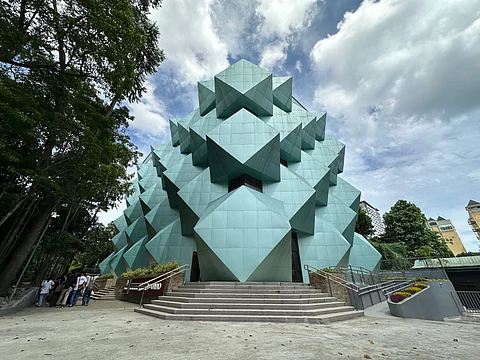
- NEWS
- the EDIT
- COMMENTARY
- BUSINESS
- LIFE
- SHOW
- ACTION
- GLOBAL GOALS
- SNAPS
- DYARYO TIRADA
- MORE

It was just last 1 December 2024 when the doors of the National Museum of the Philippines (NMP) Davao branch opened. I would have wanted to visit it immediately, but the lines of enthusiastic Davawenyos and my busy schedule meant that I had to wait for a couple of months before I made a visit, but my wait was truly worth it.
Housed in a purpose-built Durian-shaped building that is inspired by Davao’s famous fruit inside the People’s Park complex in downtown Davao, the museum is the 17th regional component museum of the NMP and is its fourth in Mindanao. With its modern facade and curious shape, the museum stands out from the rest of NMP’s other buildings which usually utilize old historic structures.
Entering the museum, one is immediately greeted by Kublai Millan’s monumental installation Ahungan ng Pagkakaisa. Inspired by the traditional musical instrument of the Tagakaolo people, also known as tangungu in Bagobo, this centerpiece was crafted by over 50 skilled Manobo weavers, signifying the power of the community.
To the left of the first floor, one can see the epic work of National Artist Victorio Edades, who spent his retirement years in Davao City. On loan from the Bangkok Central ng Pilipinas Collection, Davao Industries features the various agricultural, manufacturing and fishing industries that power Davao’s dynamic economy. Also exhibited on the same floor are works by various contemporary Davao artists.
The second floor introduces museum-goers to Davao Region’s natural landscape, from its geologic composition and transformation, to its endemic flora and fauna. There is also a section that features the region’s extinct mastodon whose fossilized teeth are worn by tribal datus.
Crowning exhibition space is the preserved remains of Philippine Eagle Geologica together with an in-depth installation showing the region’s rich forest, mountain, land and aquatic biodiversity.
Aside from featuring Davao’s natural wonders, the museum also features traditional life rituals and archeological heritage as well. Acknowledged as a melting pot for Lumads, Moros, and migrant settlers, the third floor of the museum features various ethnic expressions of the people who populate the region and how the mountainous terrains, rivers and seas continue to shape communities across historical periods, through trade, warfare and even in the conduct of their daily lives. There is also a section that features the origins of death-related practices, prevalent among various indigenous people groups, offering viewers a deeper understanding of our long-held beliefs in the afterlife.
Expressions of local artistry comprise the exhibitions on the fourth floor. The textile exhibition focuses on the clothing of the different indigenous and cultural communities in Mindanao.
Researched and curated in partnership with the Office of Senator Loren Legarda and the National Commission for Culture and the Arts, this exhibition is part of the Hibla ng Lahing Filipino Program, making NMP Davao its seventh regional gallery. It also honors the lives and works of master textile weavers from Mindanao who were recognized as Manlilikha ng Bayan or National Living Treasures.
The final gallery of the museum features a rare exhibition on the legacy of Davao-born National Artist Ang Kiukok, an influential figure in Philippine modern art. Known for this expressive, Cubist-like works, the exhibit collects works done by Kiukok from his formative years to his prime. His dynamic works featuring crucifixions, screaming figures, animals and still life done in an abstract geometric style evokes his emotions and thoughts.
It is often said that we learn the needed skills and knowledge to survive from going to school, we learn about ourselves and what shapes our culture from the museum, and the opening of the NMP in Davao is truly a welcome joy to a city that is still growing and trying to learn who we are.
